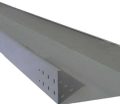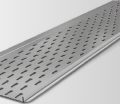
Fire safety in cable trays is critical for maintaining operational safety in industrial and infrastructure systems. Cable trays often house essential electrical systems, making them vulnerable to fire hazards. Overheating caused by electrical faults is a common issue that can lead to ignition. External factors such as welding sparks, oil spills, and the accumulation of coal dust further increase fire risks. Once a fire starts, the tightly packed cables in a tray can cause flames to spread rapidly. This can result in severe damage to the cable tray, its support structures, and even the entire cable vault. Utilizing a linear heat detector for cable tray applications is essential to detect early signs of overheating and prevent extensive fire damage.
Why Use Linear Heat Detector for Cable Tray?
Linear Heat Detector for Cable Tray Applications
Reliable Fire Detection for Densely Packed Cable Trays
Linear heat detector for cable tray applications offers a reliable solution to prevent fire hazards. These systems provide critical fire detection capabilities for areas where cables are densely packed, and traditional methods may not suffice. Their use is essential for effective early detection, simplifying fire safety management in industrial environments.
Effective Early Fire Detection in Cable Trays
Effective early fire detection in cable trays is a major benefit of using a linear heat detector for cable tray systems. These detectors monitor temperature changes along the entire length of the cable, allowing for immediate identification of overheating. This reduces the risk of undetected fires, ensuring timely responses that minimize potential damage.
Flexibility and Adaptability in Complex Setups
Linear heat detection cables are advantageous in complex setups due to their flexibility and adaptability. These systems can be installed in intricate cable tray layouts, offering consistent performance regardless of the environmental challenges. Their ability to work across long distances without loss of accuracy makes them highly suited for industrial facilities.
Applications in Industrial and Critical Infrastructure
Applications in industrial and critical infrastructure environments highlight the importance of linear heat detector for cable tray systems. Facilities such as power plants, manufacturing units, and data centers rely on these detectors to protect critical electrical infrastructure from fire hazards. Their deployment ensures that essential services are not disrupted by unforeseen incidents.
Fitting Cable Tray Guide: Step-by-Step Installation Tips
How Linear Heat Detector for Cable Tray Works
Working Principle of Linear Heat Detection Cable
Linear heat detector for cable tray systems operates through an innovative yet straightforward mechanism. The cable consists of a heat-sensitive core, often made from a polymer or metallic conductor. When the surrounding temperature reaches a predefined threshold, the material reacts by triggering an electrical signal.
Temperature threshold activation and signal transmission are integral to these systems. The cable activates the alarm system by transmitting a signal when the heat-sensitive core reacts to excessive heat. This ensures the fire detection system responds promptly to potential hazards.
Continuous, distributed temperature monitoring is another key feature. Linear heat detector for cable tray applications monitors every point along the cable’s length. Unlike traditional spot detectors, this approach eliminates blind spots, providing comprehensive coverage for the entire protected area.
Key Features of Linear Heat Detection Systems
High Sensitivity and Accuracy
High sensitivity and accuracy ensure that even minor temperature fluctuations are detected promptly. This capability is vital in environments with flammable materials, as it enables quick identification of potential hazards before fires escalate.
Compatibility with Fire Alarm Control Panels
Compatibility with various fire alarm control panels allows seamless integration into existing safety systems. This feature ensures that a linear heat detector for cable tray applications can work efficiently alongside other fire protection measures, eliminating the need for significant system modifications.
Durability and Reliability in Harsh Environments
Durability and reliability in harsh environments are defining characteristics of these systems. Designed to endure extreme temperatures, dust, and moisture, the cables maintain consistent performance, ensuring reliable fire detection even in challenging industrial conditions.
Installation and Wiring of Linear Heat Detector for Cable Tray
Best Practices for Linear Heat Detection Cable Installation
Linear heat detector for cable tray systems must be installed correctly to function effectively. Step-by-step installation guidelines ensure that the cables are placed optimally for maximum coverage. Installers must assess the tray’s layout, ensuring the cable follows the routing of potential fire hazards.
Tips for avoiding common mistakes during setup include ensuring that the cable is not placed too close to high-current conductors, which might cause false alarms. Proper fastening and spacing prevent mechanical damage, ensuring the system’s longevity.
Understanding the Linear Heat Detector Wiring Diagram
An overview of wiring components highlights the simplicity and effectiveness of the system. The wiring diagram typically includes the detection cable, termination units, and connections to the fire alarm panel. This ensures that all components are correctly linked for seamless operation.
Integration with existing fire detection systems is straightforward. Linear heat detector for cable tray applications can be added to most setups without extensive modifications, enhancing the overall fire safety strategy. Proper configuration ensures that the detector communicates efficiently with alarm systems, ensuring prompt responses.
By focusing on effective fire detection, ease of installation, and compatibility, linear heat detector for cable tray systems provide an essential safeguard for critical infrastructure. These systems help prevent costly damages, ensuring uninterrupted operations and enhanced safety for personnel and equipment.
Flexibility and Strength of Polypropylene Cable Tray Systems
Linear Heat Detector for Cable Tray:Price and Datasheets
Understanding Linear Heat Detection Cable Price
Linear heat detector for cable tray systems presents cost variations depending on several factors. The specifications of the cable, including its temperature sensitivity and material composition, play a significant role in determining the price. For example, cables designed to withstand higher operating temperatures or harsh conditions may cost more due to the specialized materials used in their construction.
The length of the detection cable is another key factor. Longer cables are necessary for large-scale applications, such as expansive industrial facilities or power plants. These installations require extended coverage, and the additional length contributes to the overall cost.
Temperature sensitivity is equally important when evaluating costs. Systems capable of detecting even minor temperature increases demand advanced engineering, which can increase initial investment. However, such sensitivity ensures precise monitoring, reducing the likelihood of fire incidents.
Long-term cost savings from effective fire prevention should be considered when assessing pricing. Although the upfront cost of a linear heat detector for cable tray systems may seem significant, these systems can prevent catastrophic losses caused by fires. For instance, avoiding downtime, costly repairs, and potential legal liabilities makes these detectors a valuable investment in maintaining operational integrity.
Importance of Reviewing Linear Heat Detection Cable Datasheets
- Technical parameters to assess before purchasing a linear heat detector for cable tray systems are critical. These include the operating temperature range, activation thresholds, and resistance to environmental factors such as moisture or corrosive elements. Selecting a system suited to the specific conditions of your facility ensures optimal performance.
- Length is another crucial parameter outlined in datasheets. It’s essential to ensure the cable’s coverage matches the layout of your cable trays. For applications in sprawling industrial complexes, cables with extended lengths provide comprehensive protection without requiring multiple systems.
- Durability and compliance with safety standards are also vital considerations. The datasheets of GangLong Fiberglass systems provide detailed information on material quality, expected lifespan, and certification to meet local and international fire safety regulations. Choosing certified cables ensures regulatory compliance and reliable performance.
- Ensuring compatibility with specific project requirements is another reason to review datasheets thoroughly. A linear heat detector for cable tray applications must integrate seamlessly into existing fire safety systems. Reviewing datasheets can confirm whether the detector is suitable for connection with the facility’s fire alarm control panels or monitoring systems. This step minimizes potential issues during installation and enhances overall system efficiency.
Enhancing Fire Safety in Cable Trays
Benefits of Linear Heat Detection in Fire Prevention
Linear heat detector for cable tray systems plays a crucial role in reducing fire risks by offering continuous temperature monitoring. These systems provide round-the-clock detection, identifying heat buildup long before ignition occurs. This proactive approach enables facility managers to address issues at an early stage, preventing fires from causing significant damage.
By detecting heat buildup, these systems reduce the likelihood of cable ignition, one of the leading causes of industrial fires. Continuous monitoring ensures that abnormal temperature increases, often caused by electrical faults or external factors, are identified quickly and addressed appropriately.
Improving response times to prevent cable vault destruction is another key benefit. The early detection capabilities of these systems allow immediate action, whether it involves shutting down electrical systems, activating suppression measures, or notifying emergency services. This prompt response ensures the fire does not escalate, protecting both infrastructure and personnel.
Long-Term Reliability in Mitigating Fire Risks
Linear heat detector for cable tray installations is designed to provide long-term reliability, ensuring uninterrupted fire protection. The robust construction of these systems, such as those offered by GangLong Fiberglass, enables them to function effectively in extreme industrial environments. Their resistance to dust, moisture, and chemical exposure makes them suitable for use in facilities such as oil refineries, manufacturing plants, and power stations.
Low maintenance requirements are an added advantage. The durable materials and construction of linear heat detection cables mean they require minimal upkeep while delivering consistent performance over time. This reduces operational costs and ensures that fire safety systems remain functional without frequent interventions.
Another factor contributing to their reliability is their adaptability. Linear heat detector for cable tray systems can be customized to meet the specific needs of any facility, ensuring optimal protection. Whether the application involves high-temperature zones or areas with heavy machinery, these systems can be tailored to address unique challenges.
Facilities using these systems benefit from enhanced protection, knowing their fire safety measures are dependable. This confidence in performance ensures that businesses can operate without interruptions caused by fire-related incidents, safeguarding assets and employee well-being.
How Polyester Cable Tray Supports Heavy Loads in Installations
Linear heat detector for cable tray systems provides an indispensable solution for fire prevention in critical infrastructure. These systems deliver continuous temperature monitoring and early detection, helping facilities address fire risks before they become emergencies. With the ability to protect assets and maintain uninterrupted operations, these detectors are essential for industries where fire safety is a priority.
Thoroughly reviewing datasheets and understanding system specifications ensures that the right linear heat detector for cable tray applications is selected. By focusing on compatibility, durability, and performance, businesses can maximize the benefits of these systems while meeting their unique fire safety needs.
Implementing these advanced fire detection systems enhances workplace safety and reduces risks to both equipment and personnel. Facilities are encouraged to invest in reliable linear heat detector for cable tray solutions, ensuring peace of mind and long-term operational reliability.
FAQs about Linear Heat Detector for Cable Tray
A heat detector typically monitors temperature changes at a single, fixed location, such as a room or specific point. It triggers an alarm when a set temperature threshold is exceeded. A linear heat detector, on the other hand, provides continuous temperature monitoring along its entire length. It is designed to detect heat at any point along the cable, making it suitable for extended and complex areas like cable trays. This capability ensures more comprehensive fire detection coverage compared to traditional heat detectors, which are limited to specific spots. Linear heat detectors are ideal for areas where heat sources may vary or be unpredictable.
A linear heat detection cable is a fire detection device designed to sense temperature increases along its entire length. The cable contains heat-sensitive materials, which trigger an alarm when a specific temperature threshold is reached. These cables are highly flexible and can be installed in various configurations, such as around cable trays, along conveyor belts, or in tunnels. They are particularly effective in environments with extensive or complex layouts, providing early warning of potential overheating or fire hazards. Their ability to continuously monitor temperature across long distances makes them invaluable in industrial and commercial fire safety applications.
A linear heat detector is used in environments where continuous and distributed temperature monitoring is necessary. It is commonly applied in cable trays, tunnels, and conveyor systems, as well as areas with high fire risk. These systems are widely installed in power plants, manufacturing facilities, and data centers to protect critical infrastructure. Their ability to detect heat along extended lengths makes them suitable for areas with complex or dense configurations, where traditional point-based detectors may not be effective. They provide reliable fire detection in both indoor and outdoor environments, including high-risk zones like chemical plants and oil refineries.
The spacing for linear heat detection depends on the specific application, environmental conditions, and the cable’s sensitivity. Typically, linear heat detection cables are installed at intervals that ensure complete coverage of the protected area. For cable trays, the cable is usually routed along the length of the tray to monitor all sections effectively. Manufacturer guidelines, such as those provided by GangLong Fiberglass, recommend appropriate spacing to maximize performance. Spacing should also consider potential obstructions, airflow patterns, and heat dissipation characteristics to ensure optimal fire detection capabilities. Always consult technical documentation to determine the best spacing for your specific installation.

As the editor of GangLong Fiberglass, I have years of experience and in-depth research, focusing on cable tray products, fiberglass solutions, and grille systems. I incorporate years of industry insights and practical experience into every content, committed to promoting the progress of the industry. At GangLong Fiberglass, my commitment is reflected in every product, from innovative cable trays to durable fiberglass solutions and sturdy grille systems. As an authoritative voice in the industry, my goal is to provide valuable information to professionals and businesses and promote forward-looking solutions.


